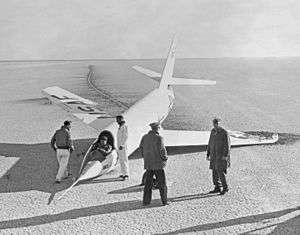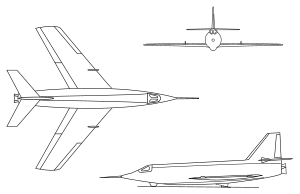Bell X-2
| X-2 | |
|---|---|
 | |
| Bell X-2 #2 with a collapsed nose landing gear, after landing on the first glide flight, on 22 April 1952 at Edwards Air Force Base. | |
| Role | Research aircraft |
| National origin | United States |
| Manufacturer | Bell Aircraft |
| First flight | 18 November 1955 (first powered flight) 27 June 1952 (first drop glide) |
| Retired | 27 September 1956 |
| Primary users | United States Air Force National Advisory Committee for Aeronautics |
| Number built | 2 |
The Bell X-2 (nicknamed "Starbuster"[1] was an X-plane research aircraft built to investigate flight characteristics in the Mach 2–3 range. The X-2 was a rocket-powered, swept-wing research aircraft developed jointly in 1945 by Bell Aircraft Corporation, the U.S. Air Force and the National Advisory Committee for Aeronautics (NACA) to explore aerodynamic problems of supersonic flight and to expand the speed and altitude regimes obtained with the earlier X-1 series of research aircraft.
Design and development
The Bell X-2 was developed to provide a vehicle for researching flight characteristics in excess of the limits of the Bell X-1 and D-558 II, while investigating aerodynamic heating problems in what was then called the "thermal thicket".
The Bell X-2 had a prolonged development period due to the advances needed in aerodynamic design, control systems, high-temperature resistant materials to be used, and other technologies that had to be developed. Not only did the X-2 push the envelope of manned flight to speeds, altitudes and temperatures beyond any other aircraft at the time, it pioneered throttleable rocket motors in U.S. aircraft (previously demonstrated on the Me 163B during World War II) and digital flight simulation.[2] The XLR25 rocket engine, built by Curtiss-Wright, was based on the smoothly variable-thrust JATO engine built by Robert Goddard in 1942 for the Navy.[3]
Providing adequate stability and control for aircraft flying at high supersonic speeds was only one of the major difficulties facing flight researchers as they approached Mach 3. For, at speeds in that region, they knew they would also begin to encounter a "thermal barrier", severe heating effects caused by aerodynamic friction. Constructed of stainless steel and a copper-nickel alloy, K-Monel, and powered by a liquid propellant (alcohol and oxygen) two-chamber XLR25 2,500 to 15,000 lbf (11 to 67 kN) sea level thrust, continuously throttleable rocket engine, the swept-wing Bell X-2 was designed to probe the supersonic region.[2]
Operational history

Following a drop launch from a modified B-50 bomber, Bell test pilot Jean "Skip" Ziegler completed the first unpowered glide flight of an X-2 at Edwards Air Force Base on 27 June 1952. Ziegler and aircraft #2 (46-675) were subsequently lost on 12 May 1953, in an inflight explosion during a captive flight intended to check the aircraft's liquid oxygen system.[1][4] A B-50 crew member, Frank Wolko, was also killed during the incident. The wreckage of the aircraft fell into Lake Ontario and was not recovered.[5]

Lt. Col. Frank K. "Pete" Everest completed the first powered flight in the #1 airplane (46-674) on 18 November 1955. By the time of his ninth and final flight in late July 1956 the project was years behind schedule, but he had established a new speed record of Mach 2.87 (1,900 mph, 3050 km/h). About this time, the YF-104A was demonstrating speeds of M = 2.2 or 2.3 in a fighter configuration. The X-2 was living up to its promise, but not without difficulties. At high speeds, Everest reported its flight controls were only marginally effective. High speed center of pressure shifts along with fin aeroelasticity were major factors. Moreover, simulation and wind tunnel studies, combined with data from his flights, suggested the airplane would encounter very severe stability problems as it approached Mach 3.[6]
A pair of less experienced but excellent pilots, Captains Iven C. Kincheloe and Milburn G. "Mel" Apt, were assigned the job of further expanding the envelope and, on 7 September 1956, Kincheloe became the first pilot ever to climb above 100,000 ft (30,500 m) as he flew the X-2 to a peak altitude of 126,200 ft (38,466 m). Just 20 days later, on the morning of 27 September, Apt was launched from the B-50 for his first flight in a rocket airplane. He had been instructed to follow the "optimum maximum energy flight path" and to avoid any rapid control movements beyond Mach 2.7. With nozzle extenders and a longer than normal motor run, Apt flew an extraordinarily precise profile; he became the first man to exceed Mach 3, reaching Mach 3.2 (2,094 mph, 3,370 km/h) at 65,500 ft (19,960 m).[2]
The flight had been flawless to this point, but, for some reason, shortly after attaining top speed, Apt attempted a banking turn while the aircraft was still above Mach 3 (lagging instrumentation may have indicated he was flying at a slower speed or perhaps he feared he was straying too far from the safety of his landing site on Rogers Dry Lake). The X-2 tumbled violently out of control and he found himself struggling with the same problem of "inertia coupling" which had overtaken Chuck Yeager in the X-1A nearly three years before. Yeager, although exposed to much higher vehicle inertial forces, as a result of extensive experience flying the X-1 was very familiar with its character, and was able to recover. Apt attempted to recover from a spin, but could not. He fired the ejection capsule, which was itself only equipped with a relatively small drogue parachute. Apt was probably disabled by the severe release forces. As the capsule fell for several minutes to the desert floor, he did not exit so that he could use his personal parachute before ground impact, and was killed.[7]

While the X-2 had delivered valuable research data on high-speed aerodynamic heat build-up and extreme high-altitude flight conditions (although it is unclear how much, as the Lockheed X-7 and IM-99 were among the winged vehicles operating at comparable or higher velocities in this era), this tragic event terminated the program before the National Advisory Committee for Aeronautics could commence detailed flight research with the aircraft. The search for answers to many of the riddles of high-Mach flight had to be postponed until the arrival three years later of the most advanced of all the experimental rocket aircraft, the North American X-15.
Flight test program
Two aircraft completed a total of 20 flights (27 June 1952 - 27 September 1956).
- 46-674: seven glide flights, 10 powered flights, crashed 27 September 1956[4]
- 46-675: three glide flights, destroyed 12 May 1953
Specifications

Data from Concept Aircraft: Prototypes, X-Planes and Experimental Aircraft[8]
General characteristics
- Crew: one, pilot
- Length: 37 ft 10 in (11.5 m)
- Wingspan: 32 ft 3 in (9.8 m)
- Height: 11 ft 10 in (3.6 m)
- Wing area: 260 ft² (24.2 m²)
- Airfoil: 2S-50 bicon
- Empty weight: 12,375 lb (5,600 kg)
- Loaded weight: 24,910 lb (11,300 kg)
- Max. takeoff weight: 24,910 lb (11,300 kg)
- Powerplant: 1 × Curtiss-Wright XLR25 rocket engine, 15,000 lbf (67 kN)at sea level
Performance
- Maximum speed: Mach 3.196 (2,094 mph, 3,370 km/h)
- Service ceiling: 126,200 ft (38,466 m)
See also
- Aircraft of comparable role, configuration and era
- Related lists
References
Notes
- 1 2 Gibbs, Yvonne (February 28, 2014). "NASA Armstrong Fact Sheet: Bell X-2 Starbuster". Armstrong Flight Research Center. Retrieved July 16, 2017.
- 1 2 3 Machat 2005, p. 37.
- ↑ Lehman, Milton (1963). Robert H. Goddard. New York: Da Capo Press. p. 351.
- 1 2 "X-2". astronautix.com. Retrieved July 16, 2017.
- ↑ Spaceplanes: From Airport to Spaceport, Matthew A. Bentley, P.11
- ↑ Machat 2005, p. 42.
- ↑ Machat 2005, p. 43.
- ↑ Winchester 2005, p. 35.
Bibliography
- Everest, Lt. Col. Frank and Guenther, John. "Fastest Man Alive." New York, E. P. Dutton, 1958. LoC 57-8998.
- Hallion, Dr. Richard P. "Saga of the Rocket Ships." AirEnthusiast Five, November 1977-February 1978. Bromley, Kent, UK: Pilot Press Ltd., 1977.
- Machat, Mike. Color Schemes of the Bell X-2." Airpower, Volume 35, no. 1 January 2005.
- Matthews, Henry. The Saga of the Bell X-2, First of the Spaceships . Beirut, Lebanon: HPM Publications, 1999. No ISBN
- Winchester, Jim. "Bell X-2." Concept Aircraft: Prototypes, X-Planes and Experimental Aircraft. Kent, UK: Grange Books plc, 2005. ISBN 978-1-84013-809-2.
External links
| Wikimedia Commons has media related to Bell X-2. |
- American X-Vehicles: An Inventory X-1 to X-50, SP-2000-4531 - June 2003; NASA online PDF Monograph
- NASA Bell X-2 Starbuster Fact Sheet
- Robert H. Goddard's contribution to the X-2's XLR25 engine